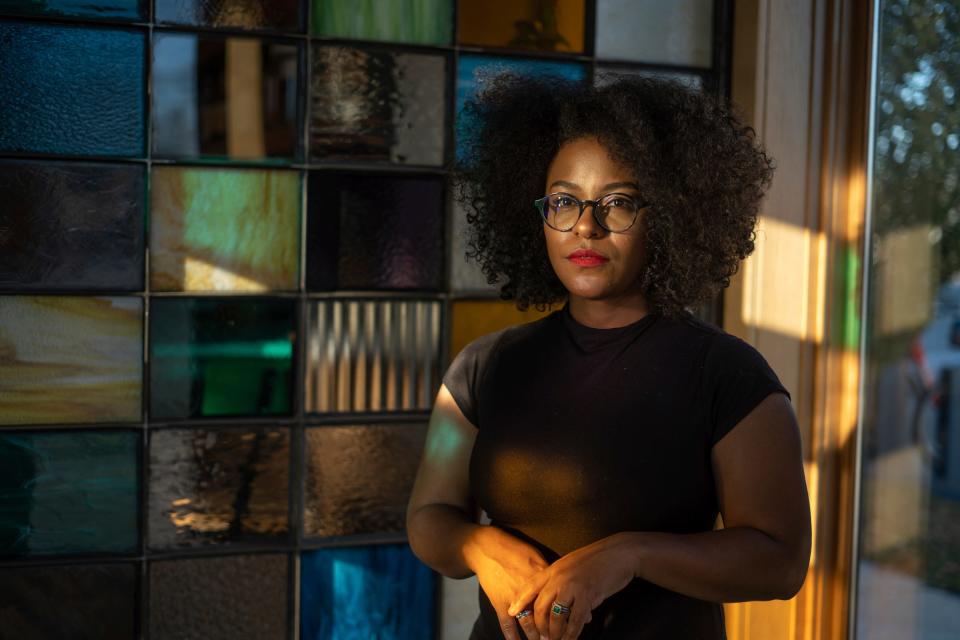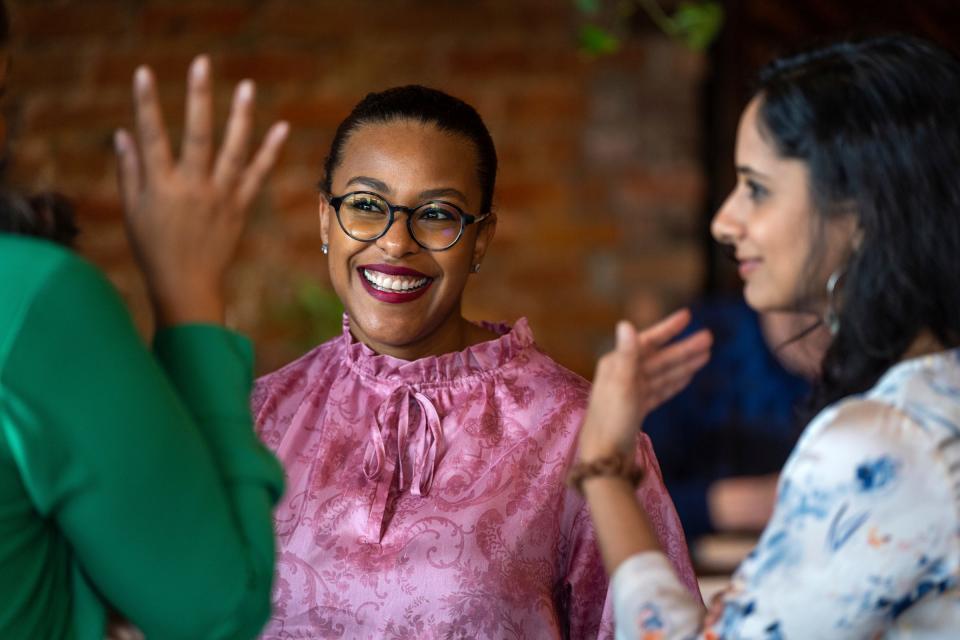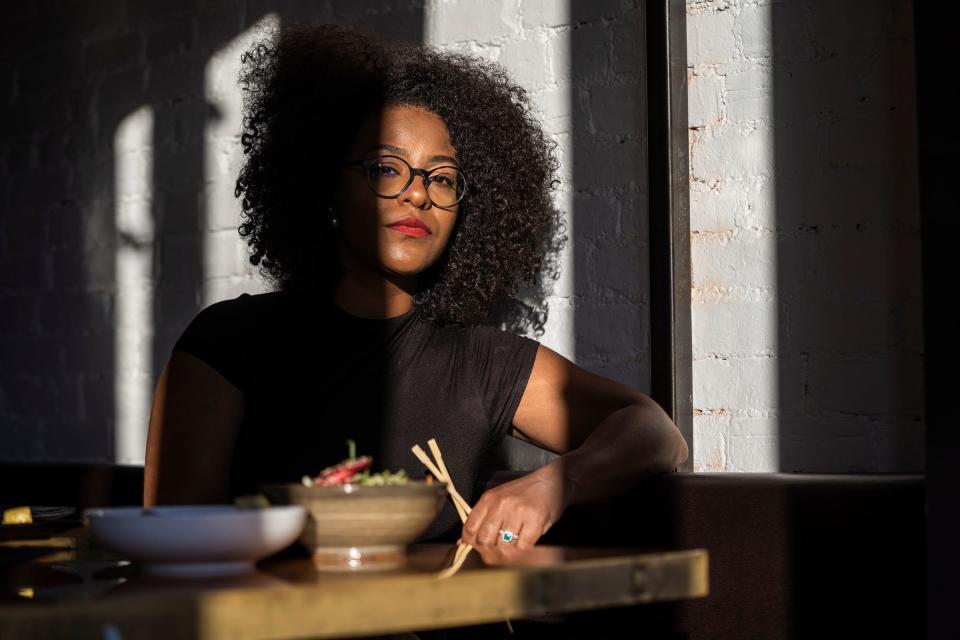My year in review as Free Press restaurant critic: Accidentally anonymous
There were two outcomes of my job interview with Detroit Free Press editor and vice president Peter Bhatia. The most obvious, my appointment as the paper’s restaurant critic, the second, a running joke.
Sitting across from me at a table at a Starbucks in downtown Detroit, Peter inquired about my thoughts on anonymity in restaurant criticism.
“I’m 4-10, Black and I have platinum blond hair,” I said to my potential future employer with a smirk. Months in quarantine seemed a safe enough time for my first major hair color experiment, but as I eased back into social settings, the hair became tricky to hide.
“It’d be quite difficult to remain anonymous for long.”

It was a risk, bringing up race in an interview — albeit stating the obvious. It was also a risk to challenge the tradition of anonymity at a paper that has prided itself on editorial integrity for more than a century.
Anonymity allows a writer to step into a restaurant without risking an outing where the staff panders to their position of power to make or break the place. (James Beard Award-winning chef and author Joseph “JJ” Johnson once told New York Magazine’s Grub Street that sales increased by 80% when a critic reviewed his former Harlem restaurant The Cecil. And reservations for nearly all restaurants on the Free Press’s 2022 Top 10 Best New Restaurants list were booked for weeks after the winners were announced.)
When restaurant critics conceal their identities, they ensure the sincerity of a dining experience. Not long ago, Sylvia Rector, the late critic who reimagined restaurant criticism at the Free Press, just barely bared her brown eyes through the tines of a silver fork in her column headshot.
Peter, whose raspy voice up until that point had been fairly quiet — serious even — let out a hearty laugh. He agreed with the sentiment and added that the paper had shed its traditional approach to anonymity in recent years. The Free Press was entering a progressive era that welcomes columnists and critics to have a more outward-facing presence. If I were to get the job, I’d still be expected to assume a level of discretion, but aliases and disguises would not be necessary.
The next time we spoke, Peter told me that he’d shared my quip with his wife. As a petite woman, she related to the self-deprecating nudge at my short stature. And during my first staff meeting at the Freep HQ, Peter asked for approval to let the newsroom in on the joke before introducing me as one of the newest members to the team. By then, my platinum blond hair had faded, clinging only to my split ends like the frosted-tips trend of the early 2000s. But the curly afro that hovered over me like a halo ensured my hair would forever be one of my most distinguishing features.
The joke became a welcome ice breaker my first week on the job.
I’ve since learned that what was even more laughable though, was the idea that my most recognizable features would make me memorable at all. Over the next year as the Free Press’s dining and restaurant critic, I’d discover that despite my big hair and tellingly short stature, my brown skin color and oversized round glasses, my penchant for red lipstick and elaborate outfits, I’d find myself entirely incognito in the costume of my own skin.
What may have been a welcome perk for the anonymous critics of yore, has instead hinted at something deeper about how America — and especially its upscale dining spheres — views, or overlooks, Black women.
Now serving, dessert
As the title suggests, my role as dining and restaurant critic is a hybrid — I’m part private eye of restaurants and translator of taste, part reporter on metro Detroit’s dining scene. It’s a split personality of sorts, one in which I am expected to maintain a low profile to ensure the dining experience of a common diner, and another where I am an industry insider, privy to restaurant and food news before it reaches the common diner. When looking to the gold standard of each of my roles, there’s an instinct to be as renowned as food writers who have risen to Food Network acclaim and yet as inconspicuous as the critics whose photos have been scrubbed from the Internet.
It’s a tightrope act to get a restaurateur to offer an exclusive tip or a hard-hat first glimpse of their next restaurant opening, only to slip in months later to review that same restaurant undetected. As an unintentional master of disguise with a superpower of invisibility though, the latter has been easy enough.
More:Many metro Detroit vegan food restaurants running on fumes, hit hard by pandemic
More:Review: Detroit's Ima Izakaya restaurant expands on Ima menu in bigger Corktown space
As curator of the annual Detroit Free Press Restaurant of the Year and Top 10 Best New Restaurants list, it is my responsibility to name the city’s most accomplished new restaurants. And as host of the paper’s Top 10 Takeover, the dinner series that trails the unveiling of the list, I recite a brief speech that recaps the reasons each restaurant earned its respective spot on the coveted list and present an award to the honored chef at the helm.

In most cases, I’ve likely interacted with the winning chef at least twice at the time of the dinner series — once for background information and again for an official interview. Then there are the mutual follows on social media. We’ve double-tapped photos taken with our spouses and reacted to images shared of our latest meals.
That’s what makes what happens next so mystifying.
It wasn't my ego or the expectation that my face was plastered on a kitchen wall as in the case of critics in big coastal cities like New York and Los Angeles, but rather genuine shock during a recent visit to one of the Top 10 Best New Restaurants when the executive chef brought a plate of dessert to my table without recognizing my face. That evening, without my recorder or an award in hand, I was just another diner. The chef happily ran down the noteworthy ingredients and the garnishes on the creamy frozen treat as I searched his eyes for a glimmer of recognition.
It was dim at the restaurant; He must not have seen my face clearly.
'Who are you with?'
With my short stature and polite instinct to take up as little space as possible, I’ve used my smallness to my advantage. In grade school, the petite, well-mannered, quiet girl could never be capable of wrongdoing. In crowds, it’s easy enough to zig-zag through the gaps between bodies like a marble on a wooden maze board. And as a restaurant critic, even in a post-anonymous era, being unrecognizable is acceptable — in many ways, preferred.
As a human being, feeling invisible is an entirely new insult.

My obscurity goes beyond my days as a restaurant critic. It goes back to my time as a beauty editor on New York City’s women’s magazine scene, when it felt as though I didn’t fit in or stand out, but rather as though I was cast aside for the taller, thinner, whiter, more personable, more confident caste. The type who was more likely to climb the ranks and therefore, more worthy of schmoozing.
Backstage during New York Fashion Week, I chatted at length with a publicist. We might have even exchanged phone numbers, advancing to a new level of professional familiarity. The next day, I’d arrived at the same tent excited to see my newfound friend. She would surely forgive my running a few minutes behind and quietly escort me backstage.
“Who are you with?” she asked, stone-faced.
She searched the list of VIPs on the clipboard she was clutching for the name and publication associated with the person standing before her. I must not have looked very important.
As hurt as I was, and as small as I felt, I found myself comforting her after clumsily uttering my name. I quickly forgave her for forgetting me.
My hair was different that day. Why should she have recognized me?
My obscurity is indiscriminate. I can slip into ambiguity no matter the race of the person I'm interacting with. There was the swanky press trip to Barcelona, where I bonded with a fellow Black writer over glasses of Spanish red wine. At an event stateside a week later, she brushed past me gingerly, apologizing for stepping on my toes as she looked for her seat a few chairs down the row. No matter how hard I smiled or tried to catch her attention, she never recognized my face.
Was it that much wine? I tried to recall.
The feeling of familiarity has become increasingly foreign. Where most people expect a fondness, a smile of recognition when you see a face you know, I’ve grown to expect something far less welcoming. That awkward dart of a person’s eyes when they’re trying to evade mine, the clear look of someone desperately trying to recall why I’d dare know their name, or that tight-lipped smirk reserved only for strangers when you’re trying to be polite. Then, there’s the eventual blush of embarrassment that comes once I’ve jogged a person’s memory.
There are the countless times co-workers have mistaken me for a new employee if I’ve straightened my hair or slicked it into a bun. Or when I've spoken at length with a food entrepreneur about their pop-up business, only to go entirely unrecognized at an event or when ordering from said pop-up weeks later. Not even the credit card in my name that I hand over sounds alarms. There are the times I’ve had to reintroduce myself to a chef I’ve interviewed on more than one occasion when ordering takeout at their restaurant. I’ve learned to skip the reminder altogether and pass like a ship in the night. It’s less awkward for both of us that way.
Sitting at the bright and airy James Oliver Coffee Co. writing this very story, I’ve had to jog the memory of two diners — one, a man I’d met only recently at a dinner party, another, a woman in the food industry who I’d consider a friend. Both with the same response after what felt like me jumping up and down and waving my hands in the air as if to say, “It’s me! Can’t you see me?” At the dinner party, he’d been kind to me, and she and I had texted just days before. At the coffee shop, as I took bites of vegan chili and sips of frothy red eyes, for a moment, neither of them had a clue who I was. There was also a Best New Restaurant owner who I didn’t bother trying to flag down.
Missus Cellophane should’ve been my name.
Who do you think you are?
I’d held out as long as I could before publishing my first less-than-savory restaurant review.
I considered all that restaurant owners were burdened with as the pandemic ushered them into a new phase of perpetual trauma. Ultimately, I’d decided the pandemic pendulum swings both ways. Just as eateries are facing unchartered challenges, diners, too are making great sacrifices to eat out. The least I could do was share an honest account when a restaurant didn’t live up to its fine dining expectations.
The review was shared and re-shared, picked up and picked apart, but no one hated the piece more than the restaurant’s owner.
She knew enough about me to track down my email, but not enough to shame me effectively. She copied the editor of the paper — it wasn’t the right paper. Even via email, I’d been so unmemorable, she didn’t have the capacity to recall the publication in which she’d read my work.
“Instead of reaching out to us, and maybe getting a little insight into what is really happening in the restaurant business, you just decide to write a very snarky review of our restaurant,” she wrote.
Coincidentally, I had sat down with her.
A few months prior, we sat at an intimate table in her empty restaurant, joined only by her husband and their publicist. We spoke at length for more than an hour over coffee to discuss the many challenges the duo faced as restaurant operators in metro Detroit.
We didn’t sit down to talk for this story, per se. I was at a different outlet at the time. She must have known that I’m the same girl — right?
'Nobody notices old ladies'
In her memoir “Garlic and Sapphires: The Secret Life of a Critic in Disguise,” (Penguin Books, 2005), former New York Times restaurant critic and University of Michigan alum Ruth Reichl quoted a friend saying, “Nobody notices old ladies,” as she attempted to convince Reichl to disguise herself as her late mother for their next restaurant outing. Reichl’s costumes were dual-purposed, mainly to conceal her identity as restaurant critic at the Times, but also to provide insight on how her appearance influenced the way restaurant staffers would treat — or disregard her.
Today, I am the Detroit Free Press’s first Black restaurant critic, and it appears, one of few, if not the only Black restaurant critic at a major newspaper in the country. What does not being noticed say when you’re a Black woman — a majority in the city you report on, but a minority in Detroit’s fine dining spaces? Could it be that my superpower of being invisible when crossing the threshold of a dining space is perhaps more sinister when examined with more scrutiny?
In a 2019 Eater essay, Korsha Wilson illuminated a missing perspective in restaurant criticism: the perspective of the Black diner. At the time of the article, it seemed there had never been a Black restaurant critic at a major publication apart from culinary historian Jessica Harris, who contributed reviews at the Village Voice in the late ’90s into the early 2000s. Nearly four years after Wilson's story was published, little progress has been made.
This brings to mind the more unnerving instances when I have been noticed. Like the time I was asked whether I belonged at a ritzy private dinner held for food writers and other members of the media, or when a woman asked if I was filling in for the restaurant critic who was supposed to give a library talk.
It couldn’t possibly be me who belonged in these spaces.
In some ways, it’s a comical story. The makings of a thrilling sci-fi about how I magically disappear in plain sight when entering a dining establishment, or any public space for that matter. But upon further reflection, perhaps this story is as much a horror as the nonfiction accounts of invisible Black women in everyday life.
Yes, I'm 4-foot-10, Black and my naturally curly hair is larger than life. But anonymity is a choice. My invisibility is inevitable.
This article originally appeared on Detroit Free Press: My year in review as Freep restaurant critic: Accidentally anonymous

